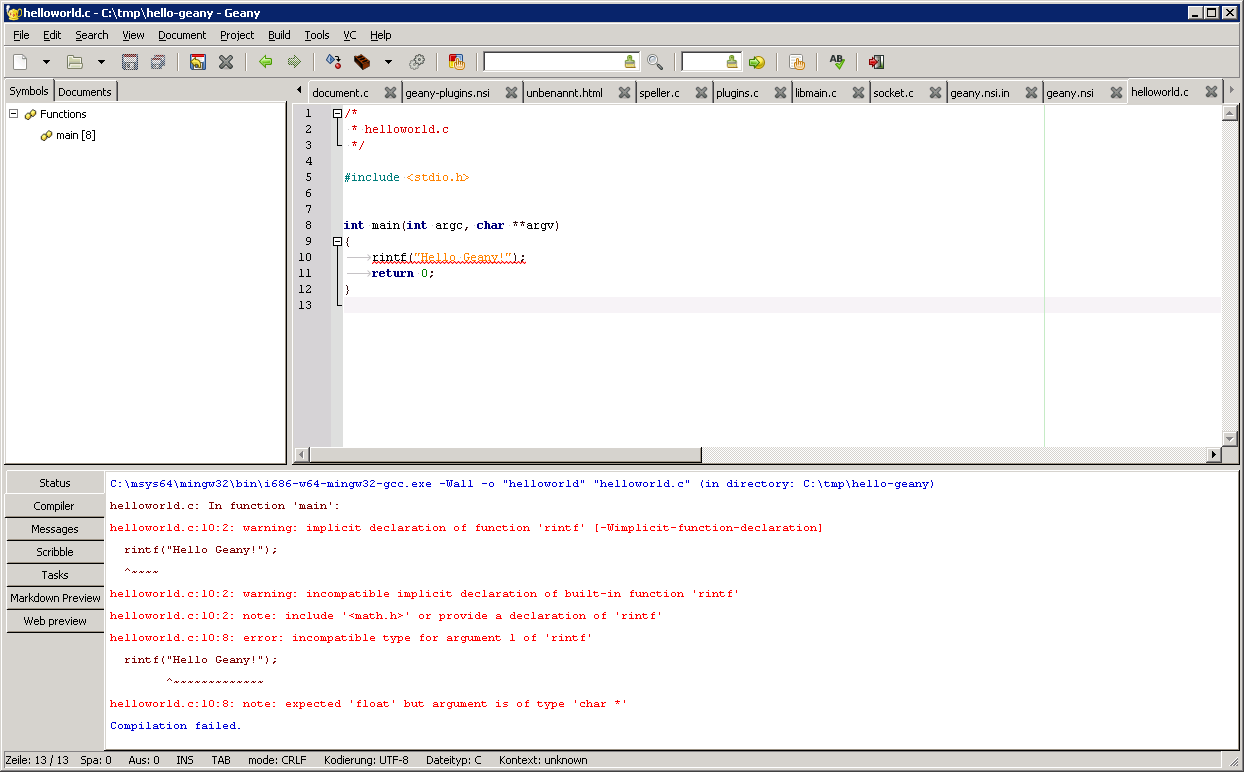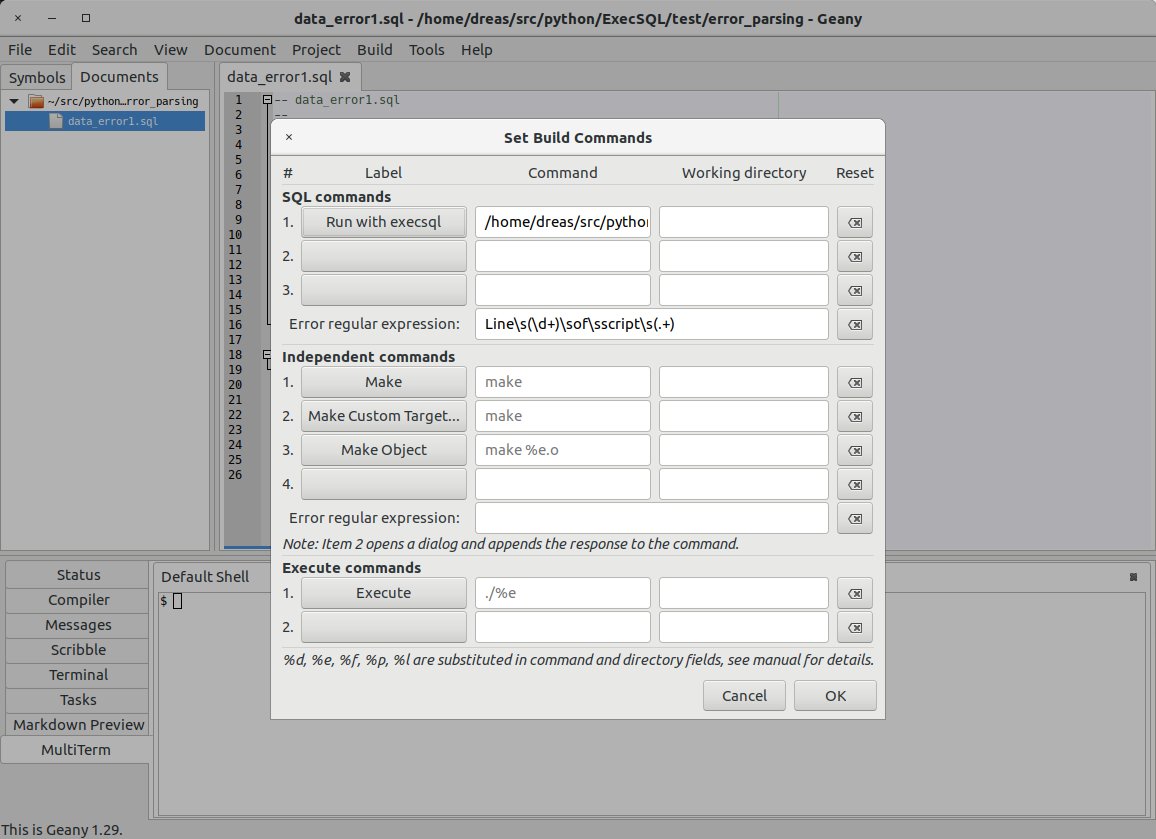
- #Geany documentation how to
- #Geany documentation install
- #Geany documentation code
- #Geany documentation mac
py extension or set the file type under document->Set Filetype->Scripting Languages->Python. In the case of python you can save the file with the. Geany needs to know your currently file type to select the compile and execute settings.
#Geany documentation code
Any code issues found are displayed in the Compiler tab and lines with problems are underlined in red in the editor. This new Check command now appears in the Geany menu under Build, and if you run it, pycodestyle, pyflakes and pylint are all run against your code. You are limited to 3 Python commands in Geany, but you can create bash scripts with multiple commands to get around this restriction. The contents of that file are as follows: echo "= pycodestyle =" You can see the Check command is referencing a bash script file in my home directory called check_python_code.sh. To open these settings go to Build->Set Build Commands. The Compile and Lint commands are setup by default, but I have added the Check command as follows. Below you can see 3 commands configured for Python.

For exampleīut you can also integrate them into Geany. These commands can be used from a terminal to check your python files.
#Geany documentation install
Pyflakes checks your dependencies and import statements sudo apt install pylint Pycodestyle checks your code formatting sudo apt install pyflakes These commands will check your code style to ensure you are formatting your code properly. I also recommend installing the Python code checker and linter commands. This is all you need to start coding in Python. You're going to want to make sure you have Python installed first off. The following command invokes the aptitude installer: sudo apt-get install geany To install Geany on Linux Ubuntu you can use the Aptitude packages installer (same goes for Raspbian). I am using Ubuntu Mate, but these instructions also work on Raspbian. To put these instructions together I am using a Raspberry Pi 4 with 4 MB of RAM.
#Geany documentation how to
How to configure Geany for Python Linux Ubuntu Install and Setup In this setup I have folder view enabled along with the editor screen split vertically to display multiple code windows.

The screen shot below gives you an idea of what Geany looks like. Geany works well for Python development and in this article I go through installing, configuring and using Geany for Python development. On Ubuntu it take about ~1second to load and runs in about 60Mb of memory.
#Geany documentation mac
} else if (isascii(sc.ch) & (isdigit(sc.ch) || (sc.ch = '.' & isascii(sc.chNext) & isdigit(sc.Geany is a lean little text editor that runs on Windows, Mac and Linux. These changes are specific to version 1.18.1, I haven't bothered to upgrade. (Geany already recognized ' 0x' as the hex designator, which is the convention of C source code). includeįinally, I came up with a change in the actual C++ code that would allow recognition of the ' $' (dollar sign) hex format still used by some assemblers. Instructions=hlt lad spi add sub mul div jmp jez jgz jlz swap jsr ret pushac popac addst subst mulst divst lsa lds push pop cli ldi ink lia dek ldx ld inc and jr rst ex call xor djnz bit jp or rrca dec set res cp lddr scfĭirectives=org list nolist page equivalent word text. # this is by default a very simple instruction set not of Intel or so the result is a "keywords" section that looks like the following, where I leave in the existing x86 symbols or whatever was already in there: Ld inc and jr rst ex call xor djnz bit jp or rrca dec set res cp lddr scfĪnd finally, adding a couple of additional directives for my assembler, e.g. Here are the instructions I added for Z80: Getting my z80 source files to look the way I wanted was just a matter of making a few small modifications to " filetypes.asm", adding the z80-specific registers, instructions, and directives specific to the asxxx assembler I am using (I should write about asxxx another time, it is pretty awesome). Configuration files for all the supported programming languages are found in " /usr/local/share/geany". It offers just a little bit of IDE functionality over the plain text editor, and the syntax highlighting is easily modified by way of configuration files and requires (almost - see below) no modification to the source code. However, after looking over a bunch of editors and IDEs available under Linux, I found that Geany provided almost exactly what I needed.

The problem with trying to beautify assembly language is all the variations in the "syntax", so it was no surprise that I found nothing off the shelf that would display my Z80 source code just the way I wanted it. Most or all of this may be covered in the Geany documentation - there may be better ways to do this but here is the recap anyway. Some time ago I spent most of an afternoon figuring out how to customize the Geany editor to recognize Z80 symbols in its assembly-language syntax highlighting.


 0 kommentar(er)
0 kommentar(er)
